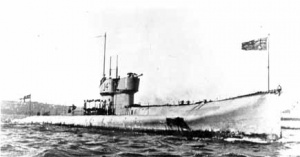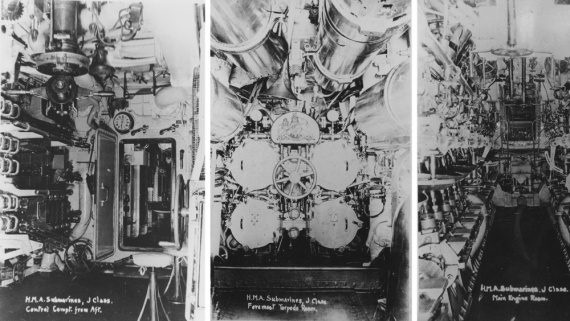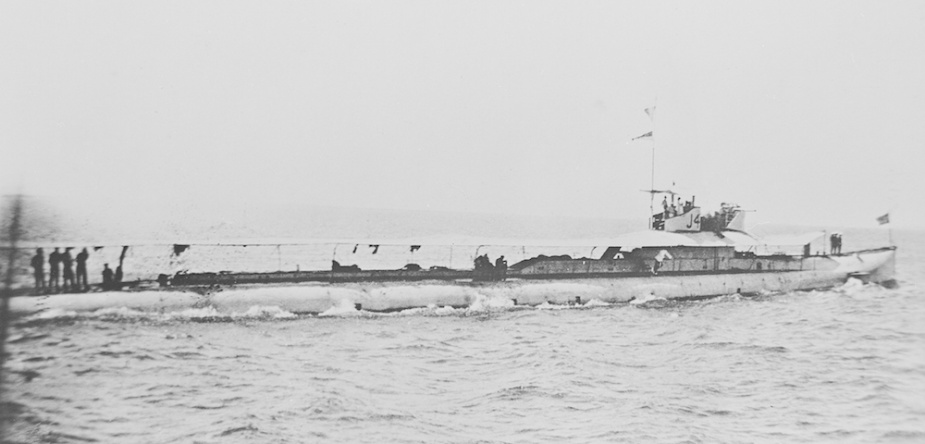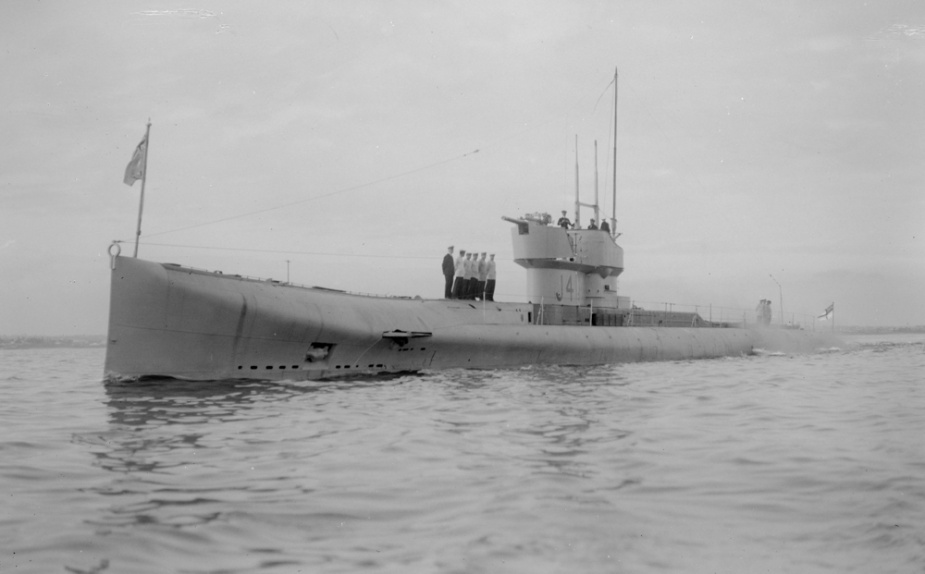HMAS J4
| Class |
J Class |
|---|---|
| Type |
Submarine |
| Pennant |
J4 |
| Builder |
Portsmouth Naval Dockyard, England |
| Launched |
2 February 1916 |
| Commissioned |
25 March 1919 |
| Decommissioned |
12 July 1922 |
| Dimensions & Displacement | |
| Displacement |
|
| Length | 275 feet 9 inches |
| Beam | 23 feet 3 inches |
| Draught | 16 feet |
| Performance | |
| Speed |
|
| Range | 4000 miles at 12 knots |
| Complement | |
| Crew | 5 officers, 40 sailors |
| Propulsion | |
| Machinery |
|
| Horsepower |
|
| Armament | |
| Guns | 1 x 4-inch gun |
| Torpedoes | 6 x 18-inch torpedo tubes - 4 bow, 2 beam |
Towards the end of 1914, early in World War I, disturbing rumours began to circulate that the newest German submarines were capable of a much higher surface speed than British boats, one report giving their speed at about 22 knots. The rumours were sufficiently strong to force serious consideration of the matter by the Admiralty, and at the same time consideration was given to the idea that submarines should have a high enough surface speed to be able to work with the fleet. The reports concerning the speed of the German submarines proved to be spurious, but the idea of a British submarine with a high surface speed gained ground. The immediate result of this concern was the development of the J Class, which were unique with their three shafts. Originally eight boats were planned but this was reduced to six and then increased to seven. As a result of these changes the boats originally intended to be J7 and J8 were renumbered in April 1915 as J3 and J4 respectively.
HMS J4 commissioned in the Royal Navy on 17 July 1916 under the command of Lieutenant Commander DI McGillevie RN and was allocated to the 11th Submarine Flotilla based at Blyth, Northumberland.
In June 1917 it was decided to conduct a large scale operation using both destroyers and submarines to flush out enemy submarines either leaving for patrol or returning to their bases from the Atlantic. Known as Operation BB, it was planned to force enemy submarines to dive through certain areas heavily patrolled by destroyers so that they would be on the surface while passing through adjacent areas patrolled by British submarines. The British submarines employed included J1, J2, J4 and J5. During the ten days, 15 to 24 June, 19 German submarines passed in or out of the North Sea; 12 homeward bound and seven outward bound. There were 26 sightings and 11 attacks made, eight by destroyers and three by submarines. J4 saw nothing of the enemy.
On 23 April 1918, the German High Seas Fleet made its last sortie of the war into the North Sea in an attempt to intercept a British convoy sailing between Norway and Scotland. At that time four British submarines were patrolling the approaches to the Bight, including J4 and J6. The German ships were not sighted by J4 and in the prevailing haze the Commanding Officer of J6 thought that they were British. No attacks were made, and the timing of the German sortie was wrong for them to catch the convoy.
The submarine was in refit at Chatham at the end of the war.
Following the conclusion of hostilities in World War I, the Admiralty in 1918 presented the six remaining boats of the J Class to the Australian Government - J6 had been sunk in error in 1918 by a British ship. All the submarines commissioned into the Royal Australian Navy at Portsmouth on 25 March 1919, as tenders to the submarine depot ship HMAS Platypus, J7 being the senior boat. The Commanding Officer of J4 was Lieutenant Ambrose N Lee RN.
The beam tubes were removed from all six J Class submarines before they sailed for Australia. The tubes were despatched separately to Garden Island. The reasons given for the removal were that the beam tubes were not a success and that increased accommodation was required.
On 9 April 1919 Platypus and the submarines, escorted by the light cruiser HMAS Sydney, sailed from Portsmouth for Australia, their first two ports of call being Gibraltar and Valetta.
On the night of 28 April, the night before the vessels arrived at Port Said, J3's starboard main engine shaft snapped. Thus handicapped she could not keep up with the others and consequently on departure for Aden on 30 April, J3 was in tow of Sydney.
The vessels arrived at Aden on 5 May. On the same day the light cruiser HMAS Brisbane, which had left Portsmouth on 17 April, also arrived. On 7 May all the vessels sailed for Colombo. Brisbane took over the tow of J3 while Sydney took J5 in tow as that boat had also developed engine trouble. Three days after arrival at Colombo on 15 May, Brisbane sailed with J5 in tow, taking her all the way to Sydney, where they arrived on 27 June.
J3 was taken in hand at Colombo for repairs. On 31 May Sydney, J1, J2, J4 and J7 sailed for Singapore, followed on 2 June by Platypus and J3. The vessels were reunited at Singapore from where all except Sydney sailed on 18 June. Sydney sailed for Australia a few days later but did not rejoin the other vessels. On 29 June Platypus and the five submarines arrived at Thursday Island, although J7 was three hours late because of trouble with her engine lubricating system. The last call before Sydney was Brisbane, Sydney being reached on 15 July.
Having arrived in poor condition, the submarines were taken in hand at Garden Island Dockyard for refitting. After her refit was completed J4, in company with J1 and Platypus, sailed on 16 February 1920 for the submarine base at Geelong, Victoria.
After uneventful service, little of which was spent at sea, J4 and her five sisters paid off into Reserve at Westernport on 12 July 1922. The boats had become victims of the worsening economic conditions of the time, coupled with their high cost of maintenance.









